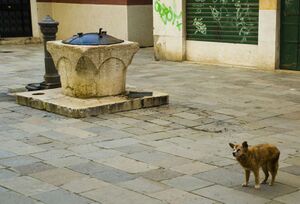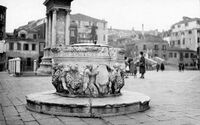Wellheads
This page is an overview of all the wellheads in Venice.
As you walk through one the many squares (campi) in Venice, you will notice one or two stone wellheads capped off by iron covers. These wellheads also known as Pozzi were at one time the only source of drinking water in Venice. Venice, being a compilation of islands in the middle of a salt water lagoon, had no access to rivers, reservoirs, springs or aquifers. So, the collection of Rainwater in cisterns under these wellheads was at one time the only feasible way for Venetians to collect fresh water. Overall there are 231 wellheads distributed throughout Venice, 217 of which are public and 15 of which are private.
Cultural Importance

While Wellheads are no longer in use, they still hold cultural and historical significance to the city. Wellheads were built with a main purpose of protecting Venice's fresh water supply from possible sources of contamination, but how they were built and designed exemplified the city’s culture and its love for art. Often, wellheads were festooned with carvings of saints, family crests, inscriptions, or other images important to Venetians; carvings of saints usually faced the nearest church. The design and decorative characteristics of wellheads vary depending on the time period in which they were built; Carolingian, Byzantine, Gothic, Renaissance, and Baroque eras are all associated with different wellhead designs.[1].
Alberto Rizzi
Alberto Rizzi has made great efforts in the field of art preservation in Venice, and is the author of the book Vere da Pozzo di Venezi. Alberto has cataloged and assigned identification numbers known as Rizzi Numbers to each of the individual wellheads in Venice. In this book, 231 public wellheads in the sestieri of Venice are cataloged. (50 in Cannaregio, 58 in Castello, 20 in Santa Croce, 23 in San Polo, 48 in San Marco, 29 in Dorsoduro, and 3 in Giudecca)[2]. In addition to those in Venice, Sixty public wellheads are located on the lagoon islands of Murano, Burano, Torcello, Lido, Malamocco, San Pietro in Volta, Portosecco, Pellestrina, and Chioggia.
While there were originally 231 public wellheads cataloged by Alberto, a recent study completed in 2000 by WPI students shows 217 public wellheads and 15 private wellheads. So 15 wellheads that were originally public have been claimed as private property of the past 30-40 years.
Map
Wellheads are designated by purple dots on the map(they are not visual until the map is further zoomed in). When you click on a dot an info box will pop up with the wellhead's Rizzi number and other information.
See Also
References
Bibliography
NULL
